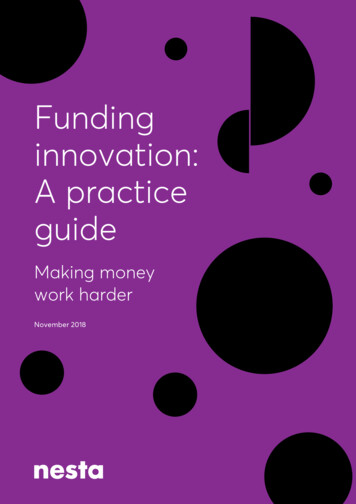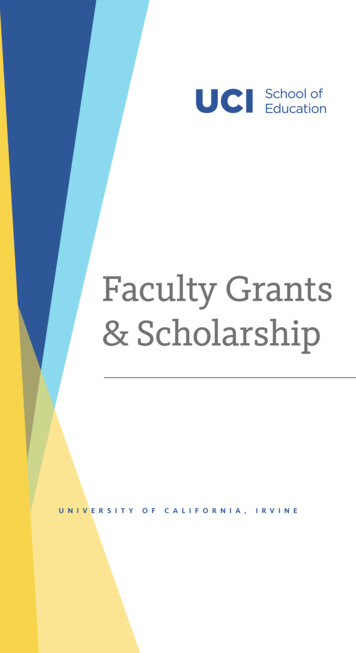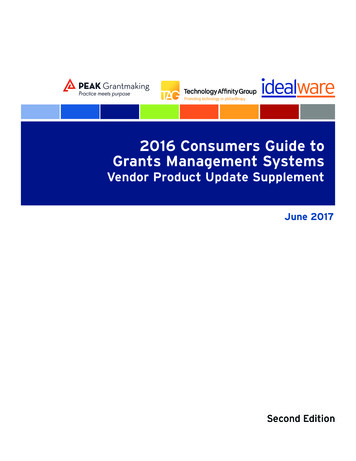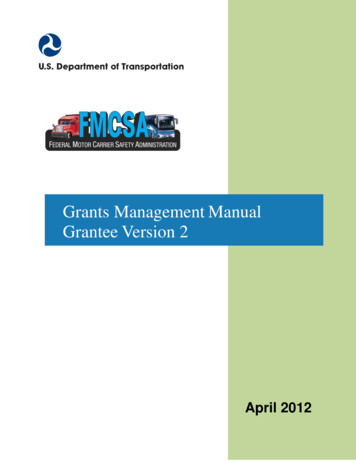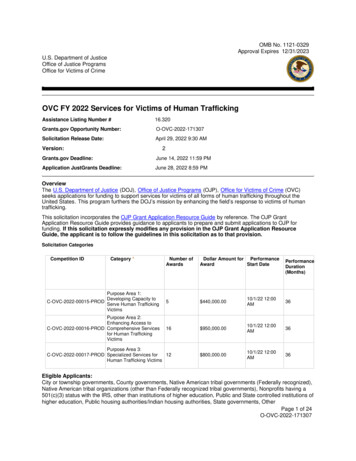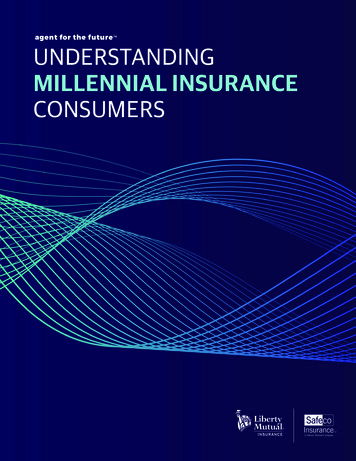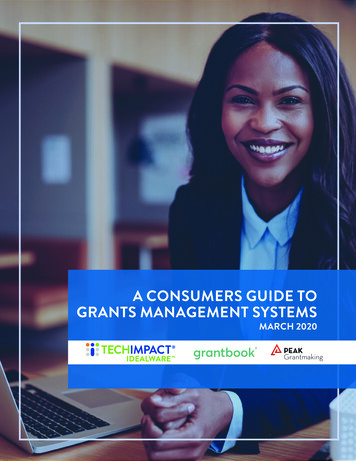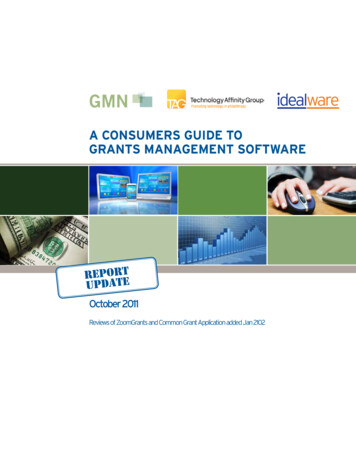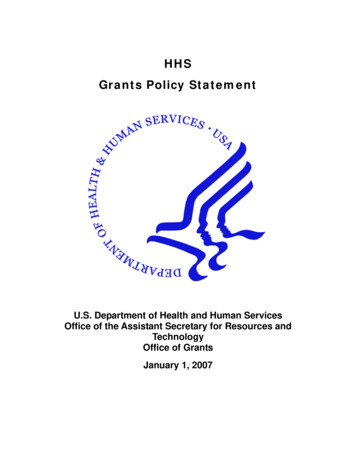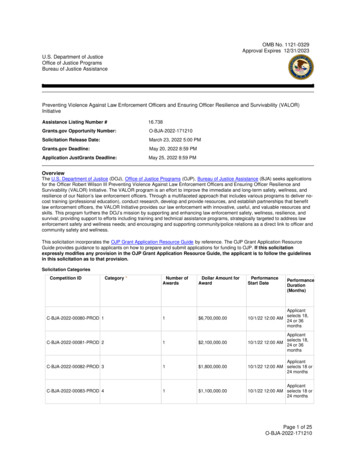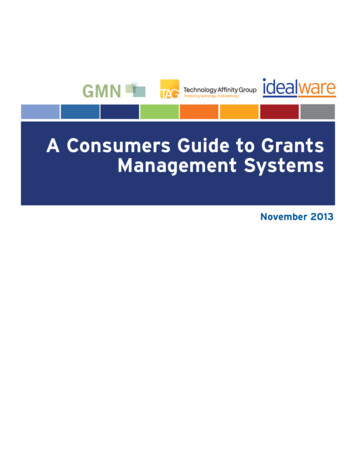
Transcription
A Consumers Guide to GrantsManagement SystemsNovember 2013
AuthorsElizabeth PopeKyle AndreiLaura QuinnMany thanks to the organizations who supported this researchThe Grants Managers NetworkThe Technology Affinity GroupAnd to the experts who contributed their timeRoberto CremoniniJonathan GoldbergLisa PoolMartin SchneidermanRebecca Van SicklePAGE2A Consumers Guide to Grants Management Systems November 2013
CONTENTSConsidering Grants Management Systems. 5Introduction. 6Do You Need a Grants Management System?. 8What Types of Systems Are Available?. 9What Do Grants Management Systems Do?. 11What Do These Systems Cost?. 22What Packages Are Available?. 23The State of the Grants Management System Marketplace. 24Comparing the Systems. 33Low Cost for Simple Needs.34Flexible Relationship Management.35Complex Online Data Collection.36Complex Application Review Needs. 37Substantial Functionality for the Needs of Large Foundations.38How to Decide.39Reviews of the Grants Management Systems.41Altum Easygrants.42Altum proposalCENTRAL. 50Bromelkamp Akoya.net.58Bromelkamp First Pearl.66Closerware GrantMaker. 74Common Grant Application.81CyberGrants.89Dulles Technology Partners WebGrants.97DonationXchange. 105Fluidware FluidReview.113JK Group EasyMatch.121Fluxx.129Foundant Grant Lifecyle Manager.137Fusion Labs GE/Spectrum. 145Mosaic GEMS.153Good Done Great Grant Management System.161GrantStream GrantRight. 169MicroEdge GIFTS Alta.177MicroEdge GIFTS. 186MicroEdge GIFTS Online. 195NPower FoundationConnect. 203PhilanTech PhilanTrack.211PAGE3A Consumers Guide to Grants Management Systems November 2013
PowerOFFICE. 219SmartSimple GMS360 .227Versaic Grants.235WESTAF’s GrantsOnline .243WizeHive .251ZoomGrants. 259Appendices.267Appendix A: Research Methodology. 268Appendix B: How We Evaluated the Systems.270Appendix C: Summary of Changes to Rubric for 2013 ConsumersGuide to Grants Management Systems. 284Appendix D: Customer Experience Survey . 286About the Report Partners. 289PAGE4A Consumers Guide to Grants Management Systems November 2013
CONSIDERING GRANTSMANAGEMENT SYSTEMS
INTRODUCTIONGrantmaking programs are complicated to manage.Even the relatively small programs can involve tracking dozens of applications, reviewers, requirements,and payments. But grants management softwarecan help by saving grantmakers time, making theirprocesses more effective and transparent, and eventransforming the way they do business.We’ll take a look at whatgrants managementsystems do, andcompare the strengthsand weakness of thepackages availablefor grantmakers.Grantmakers’ choices are growing each year, and thesystems available to them range in complexity andprice. Small packages can support straightforwardonline application, review, and progress reportingprocesses for 2,400 a year, while a specialty solutionfor a very large grantmaking organization can costupward of 200,000.How do you choose the right system for your needs?This report is a good place to start—we’ve done alot of the work for you. We’ll explore the availableoptions for accepting and reviewing applicationsand tracking grants throughout their life cycles, takea look at what grants management systems do, andcompare the strengths and weakness of the packagesPAGE6available for United States-based foundations. Thenwe’ll recommend packages that might work for yourorganization based on your specific needs.This report focuses on systems that help privatefoundations manage their grantmaking process throughthe entire grants lifecycle, including payment tracking.Community foundations differ from private foundations in several important areas, and are therefore notincluded in this report. See Idealware’s January 2012Consumers Guide to Integrated Software for CommunityFoundations for an in-depth look at these systems.You can download that report for free at ions.Note that there’s another kind of grants managementsystem entirely—one designed to help the recipientsof grants rather than grantmakers. These systems helpnonprofits manage proposal submissions and grantsthey’ve received, and confusingly, are also known asgrants management systems. We did not evaluate thisfunctionality in this report—although a few of thesesystems, such as Common Grant Application andMOSAIC, are designed to support both grantees andgrantmakers.What’s Changed Since the LastReport?We released the first edition of our Consumers Guideto Grants Management Systems in 2008, a subsequentmajor revision in 2011, and a final appendix in January of 2012. Once again, we’ve found that the field ofsystems has evolved substantially.There’s more of an emphasis on workflows toautomate processes in many of the systems, and onintegrating grants management systems with externalsources of data and other systems that a foundationuses. Grants management vendors continue to moveA Consumers Guide to Grants Management Systems November 2013
toward cloud-based delivery of their products, andthere’s a strong trend toward a more widely accessibleuser interface, so that even casual users of the systemcan find the data they need quickly.What’s New in Our Methodology?For 2013, Idealware has given our methodology afacelift, too. We’ve included seven new systems inthis report, and, for the first time, we opened up ourevaluation criteria for public review and comment.We’ve also conducted a customer survey of usersof grants management systems on their experiencewith the vendor’s support and training options,which is published alongside the longer write-upsthat discuss each system’s features and functions.Finally, we’ve incorporated the criteria from our 2010report, Streamlining Online Grant Applications: AReview of Vendors, in recognition that nearly everyvendor included in this report now supports onlineapplications. For a full summary of changes made tothe rubric, see Appendix C: Summary of Changes toRubric for 2013 Consumers Guide to Grants Management Systems, on page 285.PAGE7More advancedfunctionality, likebranching in onlineforms and robustbudgeting facility,has become far morecommon.A Consumers Guide to Grants Management Systems November 2013
DO YOU NEED A GRANTS MANAGEMENTSYSTEM?If your processes are complex enough that you’rewondering whether a grants management systemmight be helpful, it’s probably worth taking a lookat the available packages. Generally speaking, grantsmanagement processes can be complicated. Evengrantmakers who give just a dozen or so grants ayear might find a system useful—especially if theyinvolve multiple people in the review process, paygrants in more than a single payment, require progressreports from grantees, or want to look at reports thatsummarize information about their grantmaking inaggregate.Another key benefit of a packaged system, evenfor a small foundation, is the ability to collect dataonline—for example, grant applications or granteeprogress reports. If you’re considering shifting yourprocesses online, a grants management system canprovide both online and grant-tracking functionalityin a single package.As a rule of thumb, if you find your grants can’t easilybe tracked on a single Excel worksheet, a packagedsystem is worth considering. You should also lookat the available packaged options if you’re debatingbuilding something yourself, such as a MicrosoftAccess database to track grants, or web forms toaccept online applications. Custom-built functionalityis almost always a bigger long-term investment, bothPAGE8If you find your grantscan’t easily be trackedon a single Excelworksheet, you’lllikely find a packagedsystem helpful.to build and support, than organizations expect. Itshould be a last resort when it’s clear nothing on themarket will meet your needs. We reviewed strong solutions that start at under 3,000 per year, putting themwithin the reach of nearly every organization; if you’rerelying on Excel to track grants, you’ll likely findample enticement to make the move to a dedicatedgrants management system.A Consumers Guide to Grants Management Systems November 2013
WHAT TYPES OF SYSTEMS ARE AVAILABLE?As you start to consider your options, think throughwhat types of systems might work for you before considering specific systems: Online hosted or Installed,Integrated with Back Office Services, Specialized forCommunity Foundations, or Custom-Built.banks and hospitals with far greater security needs relyon similar models. Security issues are not limited toSaaS platforms; similar breaches have occurred withsystems installed on site at organizational data centersbehind company firewalls. In this year’s update, we’veasked more about how software vendors protect thesecurity and integrity of your data.It makes sense to thinkthrough what typesof packages mightwork for you beforeconsidering specificsystems.The online systems currently available typically offerstrong support for online data collection, includingonline applications, review processes, and progressreports. They range from straightforward, inexpensivepackages starting at 2,400 per year all the way up tovery sophisticated, customized systems for more than 200,000 per year.Online Hosted SystemsA growing number of grants management systemsare hosted entirely online, accessible through webbrowsers. In this model, sometimes called Softwareas-a-Service (SaaS), you pay a software vendor toprovide online access, and the software—along withall your grants data—is stored on the vendor’s servers.The benefits are that you don’t have to purchase anyhardware, the vendor handles software updates anddata backups, and your staff can access the systemfrom anywhere there’s an internet connection. Thismodel also places significantly less burden on yourfoundation’s IT department (at least in theory).But ongoing security breaches involving onlineservices have led some to question this kind of system.The truth is, it can be quite secure—in fact, manyPAGE9Installed SystemsA more traditional option, these systems are purchasedup front and installed onto your network and yourstaff’s computers. Many of these systems only run onthe Microsoft Windows operating system, so if yourorganization uses Mac or Linux machines, you mayhave a difficult time finding one that’s compatible.With this model, you’re responsible for softwareupdates and data backups.The available installed systems tend to be strong inthe kinds of features that can help your staff managea complex process, such as the ability to code grantswith keywords and easily create printed letters, butcan be weaker in online data collection. Some requireexternal modules to support online applications andprogress reports, or to let you send email from withinthe system. They typically cost more in the first yearthan the online systems, ranging from 2,400 to 200,000 or more for the first year, but many aremore affordable on a per-year basis after that.A few of the higher-end systems use a differentinstalled model, and offer software that you buy andA Consumers Guide to Grants Management Systems November 2013
install on your own web server—like Online hostedsystems, your staff can then access it from anywherethere’s an internet connection, and it easily supportsonline data collection. It also provides more controlover technical details than a hosted system. However,you’ll need to purchase the hardware required to hostthe system, and you’ll need qualified IT staff to installand update the software and back up the data. You’llalso need to ensure that the system is hosted securelyand reliably.Systems Integrated with BackOffice ServicesA few companies offer online grants managementsystems as part of a much larger service offering thatincludes staff support for a full range of back officeservices, like payment processing, mailings, accounting, and tax preparation. While this report does notfocus on service providers, one vendor provides theirgrants management package separate from their backoffice services, and we’ve reviewed that solution.Specialized CommunityFoundation SystemsCommunity foundations often have such complexrequirements on top of the more universal grantsmanagement needs that a group of software packages has been developed to meet them. Because thisreport focuses on private foundations, it doesn’t covercommunity foundation systems. See Idealware’sJanuary 2012 Consumers Guide to Integrated Softwarefor Community Foundations for an in-depth look atthese systems. You can download that report for freeat ons.better match industry best practices. And thinkthrough the long-term ramifications of becominga software developer—you’ll not only need to payto create the system initially, but to maintain it andupgrade it to match changes in your processes or othersoftware packages. The experts we interviewed for thisyear’s update reported that building custom systemsis growing less common as a strategy for grantmakers,too, so think about reaching out to peer institutionsto find out what they are considering.If you are looking into building a custom system,consider starting with a flexible platform, such asSalesforce, Microsoft’s SharePoint, or the MicrosoftDynamics CRM. This strategy can give you solid basefunctionality that can be customized and built onto meet your needs. Salesforce is a highly extendableonline system with strengths in managing constituentinformation and internal workflow. (The nonprofitconsulting firm NPower has built a grants management solution on top of Salesforce in FoundationConnect, reviewed in-depth in this guide.) SharePointprovides a toolset with sophisticated documentmanagement facilities and support for integrating online and offline data. A few of the vendors reviewed inthis guide—including Fluxx and Versaic—offer highlyflexible platforms that can be extensively configured tomeet your foundation’s needs, too.Custom-Built SystemsThis report focuses on packaged solutions, but building your own system can be a useful alternative forlarge foundations with truly unique needs. Goingdown this road merits caution, however, as it can beexpensive, lengthy, and risky. Make sure you have agood reason to build a system around your uniqueneeds rather than standardizing your processes toPAGE10A Consumers Guide to Grants Management Systems November 2013
WHAT DO GRANTS MANAGEMENT SYSTEMS DO?It’s difficult to think about your own needs or evaluate the systems that are available without a solidunderstanding of what types of features are possibleand which are common. Based on our interviews withfoundation staff and reviews of various systems, welearned a few things about what’s typically availableand about what’s desirable. More is not always better.The right system for your organization is the one thatbest supports your needs, not necessarily the one thathas the most features. Feature-rich solutions can alsobe needlessly complex, and may present an unnecessarily high learning curve for your staff.Use this section to construct a list of the features thatmight be useful to you, and then carefully prioritizethe list for your own organization.Software varies widelyin support for onlineapplications. Somepackages barelysupport them, whileothers are builtaround them.Internal TrackingAt its simplest, a grants management system needs todo two things: store basic information about grantprojects so you can easily retrieve it (for example,name, sponsor, and contact) and track the project’sstatus as it moves through your organization’s process.Useful additional features include the ability to uploaddocuments, such as proof of 501(c)(3) status, orelectronic copies of proposals in various file formats.Every system we looked at handles these basic functions, but with varying degrees of ease and flexibility.If you plan to receive grant proposals by means otherthan an online application, such as email or post,make sure the software accommodates you. Whilesome packages provide forms to facilitate data entry,others expect all grant project information to beentered by grantees and make it difficult or impossiblefor grantmakers to change project names, updatecontacts, or upload documents themselves. Some evenrequire grantmakers to log in as grantees, which is anawkward step.PAGE11The ability to categorize grant projects also varieswidely between systems. Consider how you’d like tolabel grant projects in order to group them and reporton them—for example, by grant program, by geographic or population-based categorization code, or byother fields such as dates. Will the system allow youto define new fields, or will it limit you to a few corecategories? Can you define those categories for a grantapplication or only for approved grants? Can you splitgrants across multiple categories, and track allocationsby percentage or actual dollar amount? Grantmakerssometimes need to make similar updates to dataacross several grant records. Some grants managementsystems nicely facilitate batch changes to data whileothers leave you to make such updates on a record-byrecord basis. Vendors that align to a consulting servicesmodel may perform batch updates for you.There is renewed interest in the grantmaking community in a common vocabulary, or in more technicalterms, a shared taxonomy for the sector that isA Consumers Guide to Grants Management Systems November 2013
implemented in grants management systems. Weasked vendors about their willingness to support thisstrategy, too.Online ApplicationsGrantmakers are increasingly accepting grant proposals online, which can considerably streamline operations by reducing the need to manage paper proposals,enter data, and follow up on missing information.The sector isincreasingly advocatingto streamline the onlineapplication process forgrantseekers.But grants management software varies widely in itssupport for online applications. Some systems barelysupport them at all, while others are built aroundthem. However, the sector is increasingly advocating to streamline the online application process forgrantseekers. One example of this evolution is theforthcoming project Simplify, a collaboration betweenGuideStar and TAG to create a standards-settingprocess and database that help grantees more easilyshare common data with funders. Those behind theproject hope that the vendors profiled in this reportwill modify their software so their foundation clientscan use the Simplify data in their grants managementsoftware systems.Online application processes can grow complicated,especially if you accept unsolicited proposals. Somepackages support an interactive qualifying round,sometimes called an eligibility quiz, in which applicants answer a few questions to determine whetherthey’re allowed to move forward in the process.Most allow at least a two-stage process that supportsboth an initial Letter of Intent and a more detailedPAGE12proposal. If your application process contains multiplestages, check to see if the software will roll information from one stage to the next so grantees don’t haveto re-enter a project description with a proposal ifthey’ve already entered it with a Letter of Intent. Mostsystems also allow applicants to avoid large amountsof redundant data entry by letting them reuseinformation from one application stage to another,and from one application to the next. Some systemssupport branching capabilities in online forms tocollect different information from applicants based onthe information they provide.For this update, we’ve incorporated and modernizedthe criteria from our 2010 Streamlining Online GrantApplications: A Review of Vendors report, in whichwe addressed some of the issues common to onlineapplications. For example, online forms can “timeout” unexpectedly and lead to the loss of significanttime and data entry. Some systems mitigate this byautomatically saving online form entries at regularintervals. A few simply warn users to save, while manyothers present a save button and rely on user diligenceto make sure they don’t lose any work. You shouldalso be able to save incomplete applications and returnto them. Most online application schemes let you usebrowser-based spell-checking to proof your work, buta few packages include built-in spell-checkers.Most systems allow grantees to register themselvesand set a user name and password. You can limit theregistrations by selectively sharing the web address.Some of the more advanced systems let prospectivegrantees set up multiple accounts for a single application—for example, to allow a financial staff memberto enter budget information—and transfer accounthistories between logins without contacting thefoundation or the vendor. A few even support submissions from other sources, such as references, that arekept invisible to the applicants.Once applications are submitted, applicants shouldreceive confirmation emails. Some systems let youcustomize the text of that email. Check to make suretheir application then flows seamlessly into your ownadministrative interface—if not, you’ll have to takethe time to do manual data transfers. Can applicantscheck the status of their requests online as they movethrough your review process? If not, they’ll have toA Consumers Guide to Grants Management Systems November 2013
call you for updates. You might also want the ability tocollaborate with applicants on applications in progress,and provide comments and feedback before the applications are even submitted—some systems will letyou do so. A few systems have even streamlined theonline application process so that applicants can log inand see all proposals in progress with any funders whohappen to use the grants management system to managetheir processes, rather than having to register multipleaccounts. Most systems will allow applicants to uploadattachments, in some cases including video or audiofiles—check if virus scans for such uploads conform toyour foundation’s specifications.Form Design and FlexibilityOnline applications collect information from prospective grantees in online data fields like text boxes, dropdown boxes, and checkboxes, and let grantees uploadfiles. More advanced systems might include complexbudget forms, or the ability to submit a portfolio ofwork. Most also support applications with multiplepages and sections, but only allow the use of theirbuilt-in spell-checkers. You should be able to set character limits for text fields in the system and be able todisplay prominently to applicants how many charactersare left; ideally, you can display word counts, not justcharacter counts. Most systems also let you customizein-application help for grantees, either through hoverover text, FAQs, or more innovative means, like videos.All systems allow you to customize the fields that youcollect. Some make it easy for you to add or updateapplications, while others charge you for every change.Check to see if you can customize forms with yourorganization’s logo, colors, and fonts to match the restof your website.Application ReviewOnce you’ve received grant applications, a grantmanagement system should help manage the process ofreviewing them and deciding what to fund. For simpletracking purposes, some systems provide a “checklist”to help ensure you have all the information you need toconsider a grant.Make sure it’s easy for application reviewers to see andprint all the information necessary to consider an application. For example, can you easily print a summary, orPAGE13Packages providevarying degrees ofsupport for morecomplex reviewprocesses. Can youtrack comments frommore than one person?Store complex scoringcriteria? Let peoplereview online?only a document with every field and attachment inthe proposal? Can you see whether you’ve previouslyawarded any grants to the applicant? It can also beuseful to provide reviewers a stripped-down version ofthe
to Grants Management Systems in 2008, a subsequent major revision in 2011, and a final appendix in Janu-ary of 2012. Once again, we've found that the field of systems has evolved substantially. There's more of an emphasis on workflows to automate processes in many of the systems, and on integrating grants management systems with external
